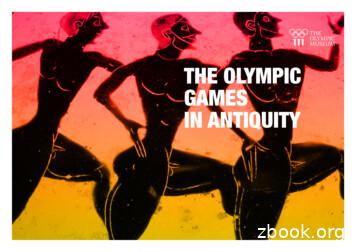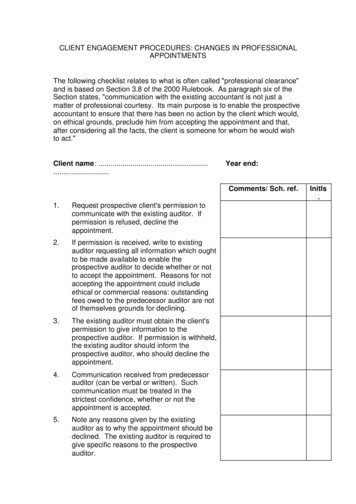Expressive And Receptive Language Games With PCS Symbols
Grades PreK - 12#GB-146Expressive and Receptive Language Gameswith PCS SymbolsWritten by Rebecca Eisenberg, M.S., CCC-SLPand Cheris Frailey, M.A., CCC-SLPArt and Design by Ted Dawson, Tim Davis, and Marty Schwartz“The Picture Communication Symbols 1981-2005 Mayer-Johnson LLCare used with permission. All rights reserved worldwide.”Post Office Box 24997, Greenville, SC 29616 USACall Toll Free 1-800-277-8737 Fax 1-800-978-7379Online! www.superduperinc.comE-Mail: custserv@superduperinc.comCopyright 2006 by SUPER DUPER PUBLICATIONS, a division of Super Duper , Inc. All rightsreserved. Permission is granted for the user to reproduce the material contained herein in limited form forclassroom use only. Reproduction of this material for an entire school or school system is strictly prohibited.1 2006 Super Duper Publications
ContentsIntroduction.3Webber Functional Communication Materials.3To Play the Game .4Game Options and Directions . 4-5Communication Boards . 6-16Around Town - Transportation and Community Helpers .6Feelings/Sensations .7Food/Drink .8Hygiene .9Objects .10Places .11Playground/Park .12School .13Senses .14Small Group - Days of the Week and Weather/Seasons .15Social .16Webber ber FunctionalCommunicationAround TCommunity ownHelpersExpressiveB2 2006 Super Duper Publications
IntroductionWebber Functional Communication Expressive and ReceptiveLanguage Games contains five fun, motivating games for teachingnon-verbal and language delayed students how to communicate usingMayer-Johnson Boardmaker Picture Communication Symbols.Students answer receptive and expressive questions about a specifictopic using one of 44 communication boards. The five game formats(Webber Functional Communication Board Game, Spinning withCommunication, Bingo, Lotto, and Tic-Tac-Toe) allow students withvarying motor and verbal skills to participate.There are 11 topic areas in Webber Functional Communication: Around Town - Transportation& Community Helpers Playground/Park Feelings/Sensations Senses Food/Drink Hygiene Small Group - Days of theWeek & Weather/Seasons Objects Social School PlacesEach topic area includes two different communication boards with18 receptive cards and 18 expressive cards that target matching,identification, sentence completion, and responding to questions. Thegames are wonderful for teaching non-verbal students to useaugmentative and alternative communication, and are also great forworking with preschoolers with language delays, children with autismand hearing impairments, and children who respond well to visual cues.Webber Functional CommunicationMaterials44 Double-Sided Communication Boards (9 ½” x 11”)11 Topic Areas with Two Different Boards per topic,(9 Pictures per Board)396 Color-coded Question Cards – 198 Receptive (2 ¼” x 2 ¼”)and 198 Expressive Cards (4 ¼” x 3 ¼”)6 Weighted Game Pieces for impaired fine motor skillsGame Board (16 1/8” x 16 ¼”)40 Foam Bingo Squares (2 ½” x 2 ½”)Electronic Spinner 2006 Super Duper Publications3
To Play the GameUsing Receptive CardsHave the student match the symbol on the Receptive Cards to thesymbols on the Communication Boards, or give the direction, “Pointto .”Using the Expressive CardsUse the Expressive Cards to work on answering questions. Cardsconsist of 3-4 questions appropriate for the topic area. Questionformats include fill-in-the-blank, WH questions, describing words inquestions, and comparison questions.Game Options and DirectionsWebber Functional Communication Board Game (PreK-6)Use the communication boards, question cards, game board, andspinner. SLP/Teacher chooses a topic area and the receptive orexpressive question/command on the card. Each student receives his/herown communication board or may use his/her own AugmentativeAlternative Communication (AAC) device. Student One hits the spinnerin the middle of the game board and moves the number of spacesindicated on the spinner. The SLP/Teacher asks the question on the cardand the student answers using his/her communication board or AACdevice by eye gaze, pointing, or other method. The number on thespinner also indicates how many foam squares the student receives.The student with the most foam squares wins!Spinning with Communication (PreK- 12)Use the playing cards and spinner for this game. Choose a topic areaand provide each student with a communication board or have studentuse his/her AAC device. SLP/Teacher chooses the questions/commandsfor play. You may use one set of cards or mix the cards if you have avariety of skill levels in the group. Student One hits the spinner and theSLP/Teacher asks a question or states the command. Student One locatesthe picture on the communication board by eye gaze, pointing, or othermethod to answer the question or uses a personal AAC device. Thenumber on the spinner indicates how many foam squares the studentreceives. The student with the most foam squares wins!4 2006 Super Duper Publications
Additional Game OptionsBingo (All Grades)Receptive – Use the communication boards to familiarize the studentswith the symbols. Play traditional bingo using the receptive languageplaying cards. The SLP/Teacher will show or state the symbol thestudents are to locate. The students place a foam square on thatsymbol on their board and play continues until a student has threefoam squares in a row to win!Expressive – Using the expressive language playing cards, the SLP/Teacherchooses the question and asks the question of Student One. Student Oneanswers the question by pointing to the communication board orresponding on his/her AAC device. Each student places a foam square onthe appropriate space. This requires each student to learn the symboleven when not answering the question. Play continues in turn with theSLP/Teacher asking additional questions to the other students. Thestudent with three squares in a row wins!Expressive and Receptive – Combine the Expressive and Receptivelanguage playing cards. The SLP/Teacher chooses the level of thereceptive or expressive task. The SLP/Teacher asks the question of StudentOne. Student One answers the question by pointing to the board orresponding on his/her AAC device. Each student places a foam square onthe appropriate space. This requires each student to learn the symboleven when not answering the question. Play continues in turn with theSLP/Teacher asking additional questions to other students. The studentwith three squares in a row wins!Lotto (All Grades)Play Lotto the same way as Bingo. To win the game, however, astudent must fill the entire board with the foam squares.Tic-Tac-Toe (All Grades)In this game, two students share the same board. Each studentreceives his/her own color of foam squares. As students answer questionsby pointing to the board or using their own AAC device, they put theirfoam squares on the appropriate spaces of the board. The first student toget three in a row wins. SLP/Teacher chooses the appropriate question level.*SLP/Teacher may assist with foam square placement if student hasdifficulty with fine motor skills.*For students with scanning difficulty or the need for minimal pictures,place the foam squares over selected spaces to decrease difficulty. 2006 Super Duper Publications5
Around TownTransportation and Community subwaytraindentistdoctorfirefightermail carriernursepharmacistpolice officerteacherveterinarian 2006 Super Duper Publications
strongsurprisedthirstytiredweak 2006 Super Duper Publications7
Food/Drink8cerealchickendessertFrench friesfruithamburgerhot chocolateice ptoastvegetables 2006 Super Duper Publications
Hygieneblow dryerbrushdental flossdeodoranthaircutlaundrylotionmakeupnail welwash hands 2006 Super Duper Publications9
letwatch 2006 Super Duper Publications
Placesairportaquariumbankgrocery ndpoolpost officerestaurantschoolSCHOOLtheater 2006 Super Duper Publicationstoy storezoo11
Playground/Park12balance beamdogduckFrisbee grassgrillhopscotchjungle gymmerry-go-roundmonkey barspicnic basketpicnic tablepondsandboxseesawslideswingwater fountain 2006 Super Duper Publications
Schoolart classbackpackboardcomputer classdeskhomeworkI need help.language artslockerlunchroommath classmusic classnotebookP.E.pencilPlease repeat.sciencesocial studies 2006 Super Duper Publications13
Senses14birdcakechipsfire truckfireworksflowersice kyscraperstuffed animalstrash 2006 Super Duper Publications
Small GroupDays of the Week and Weather/SeasonsFridayMondaySu M T W Th F SSu M T W Th F SSundayThursdayTuesdaySu M T W Th F SSu M T W Th F SweekdayweekendWednesdaySaturdaySu M T W Th F SSu M T W Th F SSu M T W Th F ter 2006 Super Duper Publications15
Social16Excuse me.Finished.Goodbye.Hello.How are you?HurtI don’t know.I don’t understand.I like that.I’m fine.I’m sorry.Leave me alone.My turn.Nice to meet you.Please.Thank you.Your turn.You’re welcome. 2006 Super Duper Publications
2006 Super Duper Publications 3 Introduction Webber Functional Communication Expressive and Receptive Language Games contains five fun, motivating games for teaching non-verbal and language delayed students how to communicate using Mayer-Johnson Boardmaker Picture Communication Symbols. Students
We study characteristics of receptive fields of units in deep convolutional networks. The receptive field size is a crucial issue in many visual tasks, as the output must respond to large enough areas in the image to capture information about large objects. We introduce the notion of an effective receptive field, and show that it
Dec 23, 1989 · example, a client might experience a receptive aphasia which impacts compre-hension of spoken and written language, while an expressive aphasia affects a client’s ability to produce spoken and written language. The Source for Aphasia Therapy covers receptive language skills, read
There are four skills in English Language one is the receptive and another is the productive skill. In receptive skills, it includes two skills listening and reading skills and in productive skills, one is speaking and. GANESH B. MUNDHE 2 P a g e writing. Successful communication involves interesting the necessary skills; in addition, we
Olympic Winter Games medals Olympic Winter Games posters Olympic Summer Games posters Olympic Summer Games mascots Olympic Winter Games mascots The sports pictograms of the Olympic Summer Games The sports pictograms of the Olympic Winter Games The IOC, the Olympic Movement and the Olympic Games The Olympic programme evolution Torches and torch .
Regional Games and Multi-Sport Games (such as Pan American Games, African Games, European Games, Commonwealth Games, Mediterranean Games, Francophone Games, Youth Olympic Games) International Tournaments organised by the IJF (Grand Prix, Grand Slam, Masters) or under its auspices (continental open and cups),
Section 3: Playground Markings Games 16 Section 4: Skipping, Hula Hoop & Elastics 25 Section 5: Catching games 32 Section 6: Relay games 41 Section 7: Ball games 48 Section 8: Fun games 59 Section 9: Frisbee games 66 Section 10: Parachute games 70 Section 11: Clapping and rhyming games 74 Useful websites 79
The Games organised at Olympia led to the development of the Panhellenic Games. These included: - The Games at Olympia (Olympic Games): every four years - The Games at Delphi (Pythian Games), 582 B.C.: every four years (third year of each Olympiad) - The Games at the Isthmus of Corinth (Isthmian Games), from 580 B.C.:
accepting the appointment could include ethical or commercial reasons: outstanding fees owed to the predecessor auditor are not of themselves grounds for declining. 3. The existing auditor must obtain the client's permission to give information to the prospective auditor. If permission is withheld, the existing auditor should inform the prospective auditor, who should decline the appointment .























